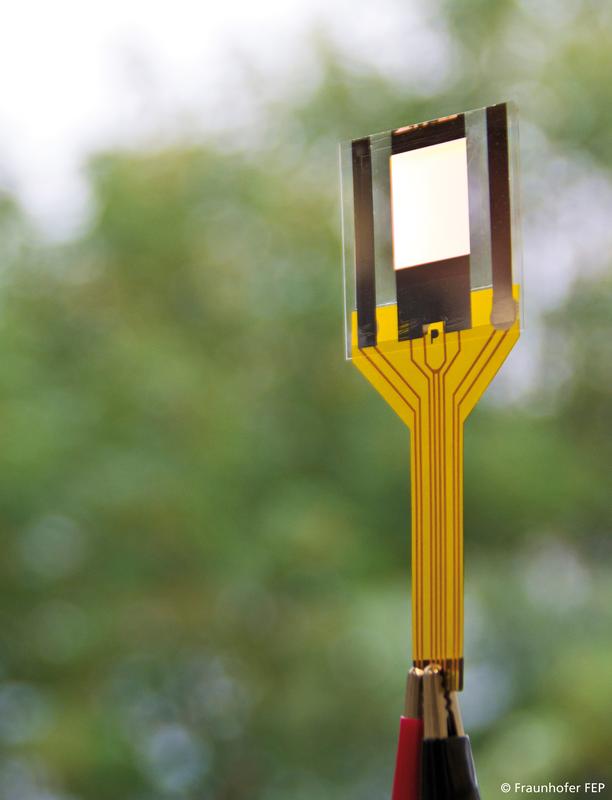Flexible electronics off the roll – more than just luminous film

Contacted OLED on thin glass
A significant growth is predicted for the market of flexible devices. The topic “Wearables”, namely intelligent, wearable systems with several useful and funny features is currently one of the major discussion topics. To enjoy more comfort, exceptional designs and higher functionality manufacturers and users ask for flexible electronic devices, like displays, lighting elements or circuit boards.
Although research and development groups have already made considerable progress in this field, not all challenges could be solved so far. Various topics are subject to further development, e.g. materials, processes, machines as well as system integration.
Fraunhofer FEP provides a roll-to-roll process line which enables the application of organic materials for OLED (organic light-emitting diodes), OPD (organic photodiodes) or OPV (organic photovoltaic) on flexible substrates in one complete technology. The process includes the structuring, automatic inspection of the initial substrates, the vapor deposition of the organics and, finally, the encapsulation of the coated films or glasses.
Organic electronics certainly require flexible electrical contacts. Therefore, Fraunhofer FEP implemented an additional printing process of metal contacts for the reliable contacting of, for example, large-area flexible OLED on metal, polymer and thin glass substrates. In cooperation with printing paste manufacturers and other suppliers, e.g. machine manufacturers, adhesive manufacturers, encapsulation film suppliers, the scientists are now able to develop optimized products for required process steps under production conditions.
Dr. Jacqueline Brückner, Project Manager Surface Analysis for the roll-to-roll organic technology, says: “Our customers have different requirements to design and mechanical stability of devices. With our know-how and our process equipment we provide a unique development platform for all these demands.”
For example, there are various solutions for the device contacting. Currently, several contacting solutions with flat ribbon cable, like ACF (Anisotropic Conductive Film)-Bonding, ACA (Anisotropically Conductive Adhesive)-Bonding or ACP (Anisotropic Conductive Paste)-Bonding are evaluated.
Examples of different contacting solutions, special contacting and encapsulation layouts for the roll-to-roll OLED processes will be presented at the booth at Plastic Electronics 2014.
Beside this exhibition, Dr. Olaf Hild of Fraunhofer FEP will give a talk with the topic “Organic Electronics and Organic Photodiodes“ at Tech Arena 1, ALPEXPO on October 7th, 12:40 pm.
About Fraunhofer FEP:
Fraunhofer Institute for Electron Beam, Plasma Technology and COMEDD FEP works on innovative solutions in the fields of vacuum coating, surface treatment and processing with electrons and plasmas as well as organic semiconductors. The core competences electron-beam technology, sputtering and plasma-activated as well as PECVD high-rate coating, technologies for the organic electronic and IC/system design provide the basis for these activities.
Thus Fraunhofer FEP offers a wide range of possibilities for research, development and pilot fabrication, especially for the processing, sterilization, structuring and refining of surfaces as well as OLED microdisplays, organic and inorganic sensors, optical filters and flexible OLED lighting.
Our aim is to develop the innovation potential of the electron beam, plasma technology and organic electronic for new production processes and devices and to make it available for our customers.
Visit us at booth no. 1032! (joint booth of Saxony)
Press contact:
Annett Arnold
Fraunhofer Institute for Electron Beam, Plasma Technology and COMEDD (FEP) | Phone +49 351 2586 452 | Annett.Arnold@fep.fraunhofer.de
Winterbergstraße 28 | 01277 Dresden | Gemany | www.fep.fraunhofer.de
Media Contact
All latest news from the category: Trade Fair News
Newest articles

Innovative 3D printed scaffolds offer new hope for bone healing
Researchers at the Institute for Bioengineering of Catalonia have developed novel 3D printed PLA-CaP scaffolds that promote blood vessel formation, ensuring better healing and regeneration of bone tissue. Bone is…

The surprising role of gut infection in Alzheimer’s disease
ASU- and Banner Alzheimer’s Institute-led study implicates link between a common virus and the disease, which travels from the gut to the brain and may be a target for antiviral…

Molecular gardening: New enzymes discovered for protein modification pruning
How deubiquitinases USP53 and USP54 cleave long polyubiquitin chains and how the former is linked to liver disease in children. Deubiquitinases (DUBs) are enzymes used by cells to trim protein…



